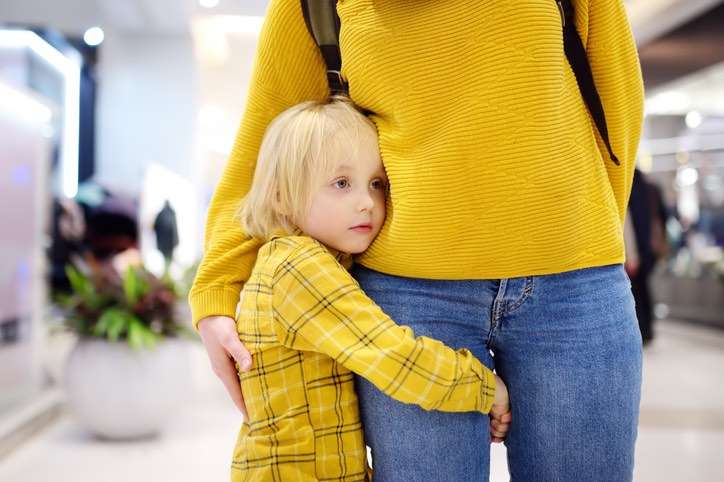What is Attachment Parenting? Pros and Cons

These days, we hear all about different types of parenting. From helicopter parenting to permissive parenting to attachment parenting, it can be hard to keep track of it all. Deciding how you’re going to parent your child can be difficult because many times we don’t know what parenting style works best for us and our children until we try it.
Let’s take a closer look at attachment parenting, the theory behind it, and what the attachment parenting style entails so you can decide if it’s right for you.
Related: Does Gentle Parenting Really Work?
What is Attachment Parenting?
The essence of attachment parenting is about forming and nurturing strong connections between parents and their children.
The term, attachment parenting, is attributed generally to pediatrician and author (The Baby Book, Nighttime Parenting) William Sears and registered nurse Martha Sears. Although there is no clinical definition of attachment parenting, this parenting orientation/style focuses primarily on noticing, appreciating, and satisfying children's needs, especially the needs of babies and young children.
Theories Behind Attachment Parenting
The Sears talk about the seven principles of attachment parenting when they discuss this parenting style. They’re often referred to as the seven “B’s”.

Birth Bonding
An example of birth bonding as part of attachment parenting can be in the form of skin-to-skin contact. This along with being together constantly is a critical step in forming a healthy long-term parent-child relationship.
Breastfeeding
Breastfeeding is seen as an essential way to nurture and soothe your baby if you’re following an attachment parenting style. It promotes physical touch and chances to respond to your baby’s hunger cues. It also prompts the mother’s body to release hormones that may boost their mothering instincts.
Babywearing
Whether it’s a baby sling, wrap, or another type of baby carrier, the idea is that babywearing promotes physical closeness and trust between the baby and their caregiver. When babies are close to their caregivers, it can also help them safely learn about their environment.
Bed-Sharing or Co-Sleeping

This is a controversial one! Bed-sharing with your baby is thought to reduce a baby’s separation anxiety at night and makes nighttime breastfeeding easier for the mom.
But there are concerns about the serious risks involved in co-sleeping such as SIDS (sudden infant death syndrome), suffocation, oxygen deprivation, and getting trapped under the covers.
If you choose to do this, you’ll want to talk to your pediatrician about the safest way to go about it.
Belief in the Baby's Cry
A baby’s cries are seen as their way of communication, not an evil way to manipulate you. When you follow an attachment parenting style, you quickly respond to your baby’s cry.
Balance and Boundaries
New parents may struggle with balance and boundaries, but over time, it’s something you can get better at as you try to find the balance between meeting your baby’s needs of your baby and maintaining your responsibilities.
Beware of Baby Trainers
The parenting philosophy of attachment parenting warns to be cautious of any advice that recommends a rigid schedule over trusting a parent’s instincts and the baby’s cues.
These “seven B’s” are meant to be tools, not hard rules. Not all of the tools will work for everyone. The purpose of this style of parenting is to help keep parents and babies close 24/7 and to teach new parents how to be responsive to their children.
Attachment Parenting vs. Attachment Theory
Many people get attachment parenting and attachment theory confused. Unlike attachment parenting, attachment theory has its roots in the work of English psychiatrist John Bowlby. He worked with kids with emotional problems in the 1930s.
He noticed that the troubled children in his care were deprived of affection and did not have much caregiving. He believed that a child’s primary caregiver provided the warm and intimate influence that kids need to develop successfully and help their well-being.
What Are Common Behaviors of Attachment Parenting?
When you embrace the attachment parenting style, many common behaviors come along with it. These include:
- Holding a new baby often
- Skin-to-skin contact with a newborn
- Starting breastfeeding immediately following birth
- Answering a baby’s cries immediately
- Co-sleeping
- No discipline through harsh punishment
- Encouraging physical closeness
As you look at these common behaviors, it’s important to note that attachment parenting sees kids being separated from their parents too often and too soon due to an unwarranted and unhealthy belief that children should not become too dependent on their parents.
Attachment parenting states that it is both normal and healthy for a child to be dependent upon her parents until she, not her parents, feels safe enough and independent enough to separate, be it a separation from the breast or the family bed.
Pros and Cons of Attachment Parenting

As you consider whether attachment parenting is right for you and your baby, it’s important to consider the pros and cons so that you can make an informed decision.
Benefits of Attachment Parenting
One of the most talked about benefits of attachment parenting has to do with breastfeeding and the closeness it brings to a mother and child. The American Academy of Pediatrics (AAP) recommends breastfeeding exclusively for up to six months and continuing with solids for up to age 1.
Another benefit of attachment parenting was seen in a 2019 study that showed that children with parents who were in tune and constantly attentive to their emotional health and physical needs were more likely to develop better language skills than children who did not experience this type of support.
Some people also argue that children who are parented under the attachment parenting style also tend to cry less and go on to better regulate their emotions as they get older.
Disadvantages of Attachment Parenting
Besides the issue of bed-sharing and the dangers of SIDS, another disadvantage of attachment parenting is the stress that it can put on parents. It can be very physically and emotionally demanding for the primary caregiver to constantly be attending to a child’s needs 24/7. It can be hard to establish healthy sleep patterns and get back to work. It can also have an impact on a parent’s mental health.
Some also argue that attachment parenting can make a child too dependent on their parents. This can lead to separation issues later in life.
The Takeaways
Attachment parenting centers around meeting the child’s needs and forming nurturing connections between parents and their children. It calls on parents to establish a close bond with their children and to be attentive to their needs. This means not letting a baby “cry it out” and looking at positive discipline or harsher methods.
Parents who choose this style may also choose to share a bed with their baby. This can lead to serious, and even deadly consequences, such as SIDS. This should be thoroughly discussed with a pediatrician so that the risks are clearly understood.
As with anything, there are advantages and disadvantages. The advantages include the close bond that can be formed through breastfeeding as well as a study that showed improved language skills. Some cons of attachment parenting not only include the risk of SIDS, but also the stress it can put on parents.
Only you can decide if attachment parenting is right for you and your baby. Remember to listen to that little voice inside of you that can help guide you along the way.
–
Want to learn more about what kind of parenting style is best for your? Check out: Your Parenting Style: Are You an Extreme Parent?

